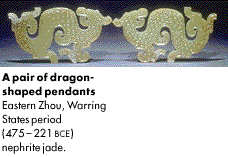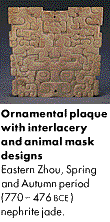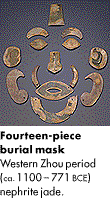


By the ninth and eighth centuries BCE, jade, as well as bronze, began to be used for ornamental as well as ritual purposes. Innovations in both bronze- and jade-working technologies permitted more elaborate shapes and surface decorations. Jade workers, using metal-tipped drills along with diamond-hard sands as abrasives, could create designs of astounding intricacy, and interchange among all artistic mediums-jade, bronze, lacquer, ceramics, wood, and textile-enormously enriched the vocabulary of motifs and the range of effects imaginable. Furthermore, as a patchwork of independent statelets replaced central political control, the new lords competed as patrons of the arts, which flowered vigorously.
The intricate interlacery on the jade plaque incorporates animal masks, scales, and claws that either revive Shang bronze designs or imitate central Asian animal style motifs popular on weapons and bronze belt fittings. Complex jade pectorals became a popular form of ornament in the Warring States period. The pair of dragon-shaped pendants were most likely worn suspended, along with other jade pieces, as a pectoral and girdle hanging down an aristocrat's neck, chest, and waist. The abstract form of the dragon pendants, S-shaped with reverted heads and curled feet, is the most popular, ubiquitous image in Warring States jade art.
